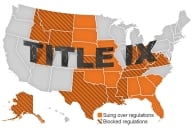You have /5 articles left.
Sign up for a free account or log in.
Men suited up to play ball with women at about two-thirds of Division I institutions in 2005-6, although only one two universities across the National Collegiate Athletic Association's three divisions said they recruited fewer female players or provided fewer scholarships because men practiced with women, according to new survey data on the use of male "practice players" released by the NCAA last week.
The debate over whether male practice players should have a role to play in women’s sports has heated up in recent months, with the NCAA’s Committee on Women’s Athletics calling for an end to the practice in December and the association’s Division III delegates taking up the issue in January.
Opinions on the enlistment of men to practice with female athletes run the gamut. The Committee on Women’s Athletics decries the use of male stand-ins for denying practice opportunities to non-starter female athletes, fostering perceptions of male preeminence, and undermining the spirit of Title IX and gender equity. Meanwhile, other women’s sports advocates -- such as the Women’s Basketball Coaches Association, which has advanced an alternative proposal to limit the use of male practice players but not ban them -- argue that, by playing against male athletes who mimic the opponents and who “are often bigger, stronger and faster,” female athletes can concentrate on their own plays and sharpen their skills.
The Division III NCAA delegates were the first group to consider formally limiting the practice in January, before voting 359-62 that they needed more data. The new survey reveals pervasive use of male practice players in all three divisions -- especially in women's basketball, but also in volleyball and soccer -- and suggests there's far greater support for limiting the practice than for banning it at the Division III level (the only level at which questions about the practice's future were posed).
Below are some of the findings from the new survey, posted on the NCAA’s Web site last week:
- About two-thirds of Division I women’s basketball teams used male practice players in 2005-6 -- the same proportion of Division I institutions that reported using male practice players in at least one varsity sport that year. About a third of women's basketball teams using male practice players reported using them almost every day.
- Meanwhile, about 35 percent of Division II institutions and 40 percent of Division III universities reported using male practice players.
- More than 90 percent of Division III universities that use male practice players opposed any ban, as did about two-thirds of those Division III universities that did not use male practice players in 2005-6. About a quarter of Division III members supported a ban on male practice players, while about half expressed support for limiting their use in terms of frequency and number. Significantly, half of those institutions that used male practice players in 2005-6 also supported limiting their use.
- About two-thirds of Division I women’s basketball and volleyball teams and more than 80 percent of Division I soccer teams reported that non-starters were not used differently when male practice players participated. Just one university each in Division I and II said the practice affected their recruiting and scholarship policies.
- Division I universities that use male practice players have done so, on average, for about seven years, and less than 16 percent of those universities have formal policies about the practice.
"The use of male practice players has gone on for many years without formal review, and it is time to consider if the practice is in the best interests of women student-athletes," Joni Comstock, NCAA's senior vice president for championships, said in an association release.
Division II and Division III committees will share the survey results and solicit further feedback from members, according to the release -- but whether that will result in the presentation of any formal proposals to modify the practice at the 2008 convention is still unknown.








